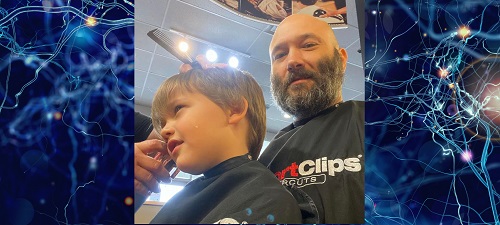Notice the tear on my son’s cheek. The other day, I took my son, Charlie, to get a haircut. Charlie has never liked getting his hair cut. He gets nervous. The closer the time came for his haircut, the more and more nervous he felt. When it was his turn in line, he felt so nervous, he wrapped his little arms around my neck and his little legs around my waist, and he anxiously protested not to get his haircut. Tears streamed down his face as he furiously cried, hoping that I would change my mind.
As parents, we oftentimes feel a sense of urgency to get our kids to perform, behave, or act a certain way, especially in public when every eye of the room is looking at us. It can feel as though those looking in are huddled around us, breathing angrily down our neck about to judge our every move. It is easy during those moments when we feel that sense of urgency to calm our emotionally dysregulated child, to use logic and rationale, to lecture, to problem solve, to bribe our children with a reward, or to threaten with consequences, all in hopes of our children doing what we ask.
In that moment in that little shop I felt that sense of urgency. Within a span of 1-2 minutes, I used it all. I used logic and rationale with Charlie. I attempted to problem solve. I bribed him with probably the entire metro area’s worth of suckers. Nothing worked. In fact the more I tried, the more clingy he became and the more he protested. He was in his limbic area, which is the more emotional part of his brain, and I was not connecting with that part of his brain. In our attempts to help, many times we attempt to connect with the wrong part of our child’s brain. What our children need is for us to enter into their little world and come alongside them. I took a deep breath; then, I knelt down on my knees and held him. I wiped his tears away from his face. Then, I asked him if he would like for me to sit in the chair with him, and that’s what we did. Obviously, I don’t need a haircut, but I got into the chair, put on the barber smock and held Charlie as he got his haircut. I got his hair all over me, but I didn’t care. My little boy’s crying stopped, his anxious clinging stopped, and he was able to not only tolerate but to also enjoy getting his haircut.
At KidsTLC, we seek to help parents and caregivers enter into the inner world of their child by understanding how their child feels and empathizing with their child first. We understand the importance of connecting with the more emotional part of the child’s brain before working to help the child make sense of the world around them and how they fit into it. We recognize it is messy at times. We recognize it is not easy. There may be times, like mine, that we don’t need the haircut. It may even appear silly to those looking in. Yet, at KidsTLC we understand that helping parents and caregivers wrap the barber’s smock around their neck, hop up into the barber’s chair while they hold their child as their child receives a haircut is what all of our children need.
Drew Ryan is an Outpatient Therapist at the Lotus Clinics at KidsTLC and previously worked as a Residential Therapist in KidsTLC’s Psychiatric Residential Treatment Facility.

